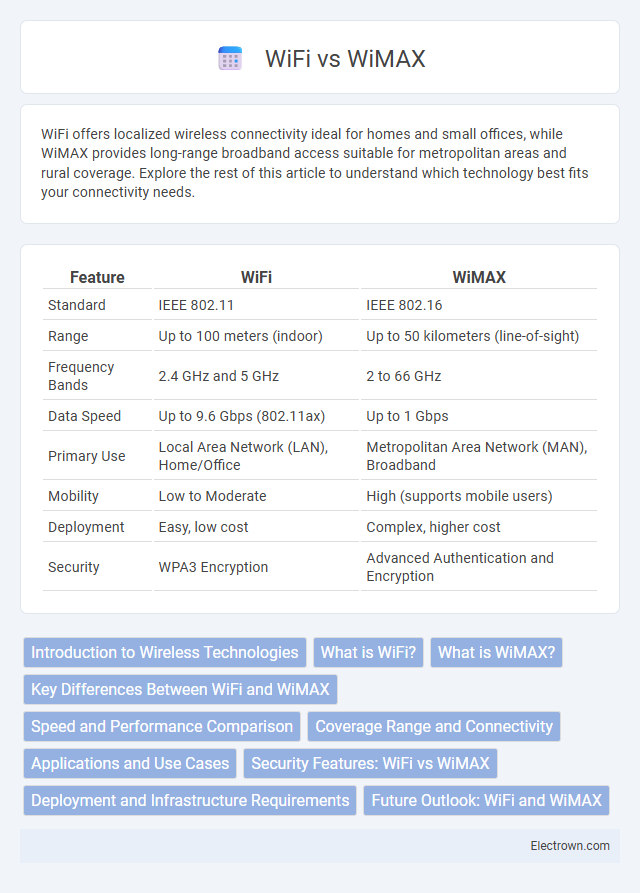WiFi offers localized wireless connectivity ideal for homes and small offices, while WiMAX provides long-range broadband access suitable for metropolitan areas and rural coverage. Explore the rest of this article to understand which technology best fits your connectivity needs.
Table of Comparison
| Feature | WiFi | WiMAX |
|---|---|---|
| Standard | IEEE 802.11 | IEEE 802.16 |
| Range | Up to 100 meters (indoor) | Up to 50 kilometers (line-of-sight) |
| Frequency Bands | 2.4 GHz and 5 GHz | 2 to 66 GHz |
| Data Speed | Up to 9.6 Gbps (802.11ax) | Up to 1 Gbps |
| Primary Use | Local Area Network (LAN), Home/Office | Metropolitan Area Network (MAN), Broadband |
| Mobility | Low to Moderate | High (supports mobile users) |
| Deployment | Easy, low cost | Complex, higher cost |
| Security | WPA3 Encryption | Advanced Authentication and Encryption |
Introduction to Wireless Technologies
WiFi and WiMAX are both wireless communication technologies designed to provide internet connectivity but differ significantly in range and application. WiFi, operating primarily in the 2.4 GHz and 5 GHz bands, serves local area networks (LANs) for short-distance access, ideal for homes and businesses. WiMAX, utilizing frequencies from 2 GHz to 66 GHz, supports wide area networks (WANs) with longer range and higher speed, making it suitable for metropolitan and rural internet coverage.
What is WiFi?
WiFi is a wireless networking technology that uses radio waves to provide high-speed internet and network connections within a limited range, typically up to 100 meters indoors. It operates primarily on the 2.4 GHz and 5 GHz frequency bands, supporting devices such as laptops, smartphones, and tablets in homes, offices, and public hotspots. WiFi adheres to IEEE 802.11 standards, offering flexibility and ease of deployment for local area networking without the need for physical cables.
What is WiMAX?
WiMAX (Worldwide Interoperability for Microwave Access) is a wireless communication standard designed to provide high-speed broadband access over long distances, typically up to 30 miles. Unlike WiFi, which is commonly used for short-range connectivity within homes or offices, WiMAX offers greater coverage and supports metropolitan area networks (MANs). Understanding WiMAX can help you evaluate options for wide-area wireless internet services or extending network access beyond typical WiFi range.
Key Differences Between WiFi and WiMAX
WiFi operates primarily as a local area network (LAN) technology with a limited range of up to 100 meters, ideal for indoor internet access in homes and offices, while WiMAX functions as a wide area network (WAN) technology designed for long-range wireless broadband connectivity extending up to 50 kilometers. WiFi uses the IEEE 802.11 standard to deliver high-speed internet at lower frequencies, typically 2.4 GHz and 5 GHz, whereas WiMAX employs the IEEE 802.16 standard operating on higher frequency bands such as 2.3 GHz, 2.5 GHz, and 3.5 GHz to provide greater coverage and capacity. Your choice between WiFi and WiMAX depends on the scope of coverage required; WiFi suits localized, short-distance environments while WiMAX is preferable for metropolitan area network (MAN) deployments offering broader, wireless broadband access.
Speed and Performance Comparison
WiMAX offers significantly higher speeds and broader coverage compared to WiFi, supporting data rates up to 1 Gbps in ideal conditions, while WiFi typically maxes out around 600 Mbps with the latest standards like WiFi 6. WiMAX is designed for long-range, outdoor network access, providing consistent performance over several kilometers, whereas WiFi is optimized for short-range, indoor environments with limited coverage and potential interference. Understanding these differences helps you choose the right technology based on your speed and performance requirements.
Coverage Range and Connectivity
WiFi typically offers a coverage range of up to 100 meters indoors and 300 meters outdoors, making it ideal for localized area networking within homes and offices. WiMAX extends connectivity significantly farther, covering distances up to 50 kilometers, suitable for metropolitan area networks and providing broadband access in underserved regions. While WiFi supports multiple devices within limited ranges, WiMAX maintains stable connections over wider areas with higher data throughput, enhancing broadband wireless access for larger populations.
Applications and Use Cases
WiFi is primarily used for short-range wireless networking in homes, offices, and public hotspots, supporting high-speed internet access for devices like laptops, smartphones, and tablets. WiMAX offers broader coverage and higher bandwidth, making it suitable for metropolitan area networks, rural broadband access, and backhaul connections for cellular networks. Your choice depends on whether you need localized connectivity with WiFi or wide-area network solutions with WiMAX.
Security Features: WiFi vs WiMAX
WiFi security primarily relies on WPA3 encryption protocols, supporting robust protection such as AES-based encryption and secure key management, but its vulnerability to rogue access points demands vigilant network monitoring. WiMAX implements advanced security features including mutual authentication, stronger encryption algorithms like 3DES and AES, and a robust PKI-based key management system, offering enhanced defense against eavesdropping and tampering over wide-area wireless networks. Your choice between WiFi and WiMAX security should consider the specific application environment, with WiMAX providing superior enterprise-grade protection for metropolitan-scale deployments.
Deployment and Infrastructure Requirements
WiFi deployment relies on relatively simple infrastructure, using access points connected to existing local networks suitable for short-range coverage within homes or offices. WiMAX requires more complex infrastructure, including base stations and licensed spectrum, designed for wide-area coverage that can span kilometers, ideal for metropolitan or rural broadband access. Your choice depends on coverage area needs and investment capacity, as WiMAX supports large-scale deployments while WiFi excels in localized environments.
Future Outlook: WiFi and WiMAX
WiFi continues to evolve with WiFi 6E and emerging WiFi 7 standards promising higher speeds, lower latency, and improved capacity for dense environments, making it ideal for residential and enterprise use. WiMAX faces limited adoption but retains niche applications in rural broadband and last-mile connectivity due to its long-range capabilities and reliable performance. The future sees WiFi dominating urban and indoor scenarios while WiMAX may persist in specialized sectors involving wide-area wireless access.
WiFi vs WiMAX Infographic

 electrown.com
electrown.com